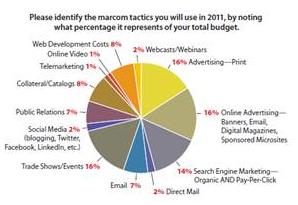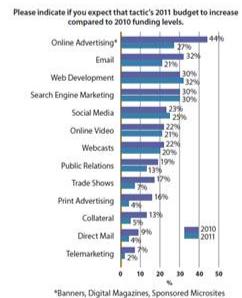An annual marketing budget survey of business-to-business marketing trends released today is showing that marketing departments are going to increase their budget in Social Media and in Search Engine Marketing in 2011. The study was conducted jointly by Goldstein Group Communications and Hearst Business Media.
When asked how spending would change next year, 44% of those who responded reported no change to budgets, a full 11 points higher than a year ago. Continued recovery is still forecast by many, with 27% projecting an increase and just 6% pointing to budget decreases.

The allocation of traditional to online approached parity in this year’s study, 51% traditional to 49% online. Two years ago, marketing budgets still were split 60-40 traditional to online. On the traditional side, print advertising and trade shows stayed relatively constant from last year to this year, and most reported that their spending in these areas would hold steady. Printed literature and direct mail continued to erode in priority on the traditional side. In online spending patterns, search engine marketing and online advertising continue to consume larger portions of the budget. Social media and online video, the darlings of every conference and trend forecast article, remain fringe areas of the budget despite the tremendous amount of attention they receive.

Marketers seem to recognize that Google, Yahoo! and Bing have become the front door for purchase decisions today, and that search engine presence is a key driver to getting their company’s fair share of sales.
Web development, online advertising and search engine marketing will consume 38% of budgets in 2011 and are the clear priority of decision-makers as they’re crafting spending plans for the coming year.
The study was conducted via email during November, 2010 to a national database of marketing decision makers. Eighty-four people responded, ranging from CEOs (25%) to Marketing Communications (21%) to Marketing professionals (36%). Company revenues in the study were evenly distributed, with 16% reporting revenues above $151 million, 12% from $51-150 million, 26% from $11-50 million and the remainder less than $11 million.